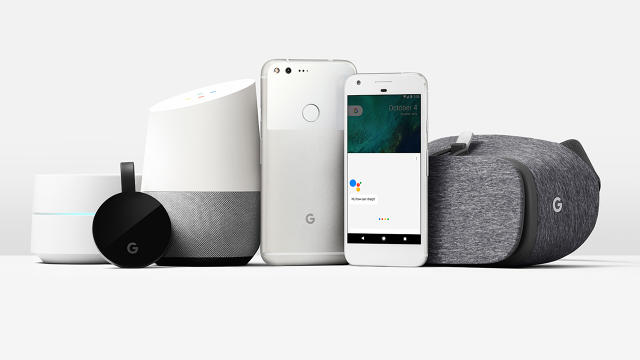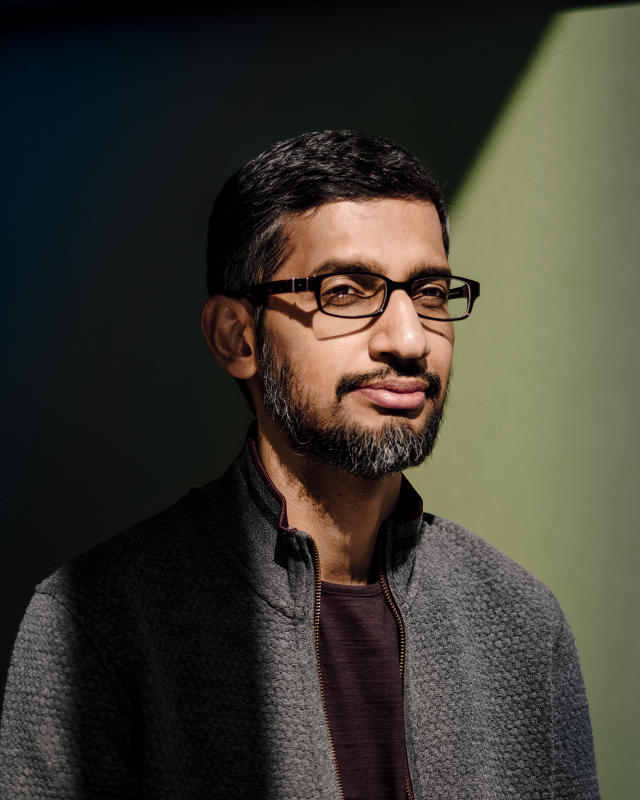Sundar Pichai is huddling with five Google staffers in a room next to his office that’s known—appropriately enough—as “Sundar’s Huddle.” The employees are members of the Google Photos team, and they’re here this morning to update Pichai on something they’ve been working on for months.
The group has barely begun its presentation when Pichai starts peppering them with questions, opinions, and advice. For half an hour, the discussion careens from subject to subject: the power of artificial intelligence, the value of integrating Google Photos with other products such as Google Drive, the importance of creating an emotional bond with the users of an app. After the team shows Pichai a rough cut of a promotional video, his feedback is unguarded and heartfelt: “That’s awesome!”
Google’s bearded, 44-year-old CEO is, unmistakably, in his element. “Nothing makes me happier than a product review in which I can sit with the team and they’re showing me something they’re building,” Pichai had told me a few days earlier. “Being able to react to it and think through, ‘When users get this, what will their feedback be?’ I’m always on a quest to do that better and do more of it.”
Pichai’s tone at the meeting—affable, engaged, ambitious—encapsulates his approach to running Google. In the year since he was named CEO, he’s been busy reshaping the company into a more harmonious, collaborative place in a quest to improve the productivity of an already inventive culture.
Pichai took charge at a pivotal moment. In August 2015, cofounder Larry Page split what had been Google into multiple units that now live under a new corporate umbrella, Alphabet, run by Page as CEO. Pichai’s Google is responsible for most consumer services and products, including search, Gmail, YouTube, Android, and hardware such as phones. With his distinctive blend of enthusiasm and curiosity, he has shuffled many of the business’s moving parts, putting longtime Googlers in new roles and hiring fresh talent to pursue a forward-looking interpretation of the company’s foundational mission: organizing the world’s information and making it universally accessible and useful.

Results are starting to arrive at a fast clip. This fall, it held two major product launches in San Francisco less than a week apart. At the first, it unveiled Google Cloud, a big expansion of offerings for business customers, such as the G Suite assortment of productivity tools (formerly known as Google Apps). The second was an Apple-esque hardware extravaganza at which the company announced the first Google-designed smartphones (the Pixel and Pixel XL), as well as a competitor to Amazon’s Echo speaker (Google Home), a virtual-reality headset (Daydream View), a wireless router (Google Wifi), and an upgrade to its video-streaming gizmo (Chromecast Ultra).
The wide scope represented by that lineup may suggest that Pichai isn’t picking his competitive battles. But his key ambitions are bound by a core prediction: that the world is moving from the smartphone age into, in Pichai’s phrase, an “AI-first” era, in which Google products will help people accomplish tasks in increasingly sophisticated, even anticipatory ways. The Pixel phones and Google Home, for instance, are the first devices with embedded support for Google Assistant, a rival to Apple’s Siri and Amazon’s Alexa that is designed not only to handle straightforward commands but also fuzzier requests such as “Play that Shakira song from Zootopia.” The Assistant is also designed to engage in relatively complex conversations related to tasks such as making vacation arrangements.
“We think of the Assistant as of an evolution of Google search,” says John Giannandrea, who, as senior VP of search, research, and machine intelligence is responsible for the technologies that power both Google search in its classic form and the Assistant. “It’s a superset in some senses. If you said to Google search, ‘Get me a pizza,’ nothing happens. Our aspiration is that the assistant will go and get you a pizza. We don’t today, but that’s our aspiration.”
Related Video: Why Google CEO Sundar Pichai Is Doubling Down On Machine Learning
Each of the tech titans Google competes with in various ways—Amazon, Apple, Facebook, Microsoft—has sweeping AI initiatives of its own, and Siri and Alexa have major head starts with consumers. But Google—which built the Assistant using concepts it’s already been exploring in Google Now and Google voice search—has more experience teaching computers to understand language, photos, and other forms of information than anyone else. Google Assistant will be able to call on those technical underpinnings as it battles it out in the marketplace. “We’ve invested in machine learning for a long time, in anticipation of this moment,” Pichai says.
Though the most out-there moonshots that Page has championed have been spun out into other parts of Alphabet, Pichai thinks that Google’s present efforts have plenty of epoch-shifting potential. “Larry always challenges all of us to think on a much, much bigger scale,” says Pichai of his boss. “He has a healthy disregard for constraints and wants us to stay focused on solving big problems. He cares deeply about using technology to help others, and reminds me of the immense responsibility we have as Google to help make the world a better place.”
“Building general artificial intelligence in a way that helps people meaningfully—I think the word moonshot is an understatement for that,” Pichai says, sounding startled that anyone might think otherwise. “I would say it’s as big as it gets.”
The CEO As People Person
Pichai’s aspiration to build hyper-ambitious products is classic Google. His managerial style, however, is strikingly different from that of Page, who is legendary for setting expectations so high that meetings can be scary as well as inspiring. When you discuss Pichai with people who work closely with him, they mention his empathy, his humor, his eagerness to encourage teamwork across the company—and how he uses them to achieve his lofty goals for the company.
“We’re proud that this is a nice guy who’s gotten to the top—someone who cares about other people,” says Caesar Sengupta, a longtime Pichai protege and VP in charge of Google’s efforts in emerging markets. “But at the product strategy level, he’s been an amazing visionary.”

According to Philipp Schindler, an 11-year Google veteran who, as the company’s chief business officer, manages a 15,000-person sales and operations group, Pichai “is as smart and thoughtful as you can be. He also has this ability to change perspective and look through other people’s eyes. That’s something that you don’t find so much in our world.”
Though Pichai is not a spotlight-hogger—at the San Francisco hardware launch, he briefly introduced the proceedings and then got off the stage—he claims to relish being a public face of Google, a responsibility that Page mostly sidestepped. Which is why, when Schindler was entertaining the CEO and chairman of one of the world’s largest consumer-goods companies at home, he didn’t hesitate to invite his boss over to help tell Google’s story over dinner. (Fortunately, he notes, “Sundar lives two minutes from my house.”)
“I really care about communicating what we are trying to do, our intent behind it,” says Pichai, who can stroll in seconds from his desk, through a door, and into Google’s sprawling “Partner Plex” welcome center, allowing him rapid access to Google’s many visitors, from advertising clients to foreign dignitaries. But he underlines that these interactions are as much about listening as talking. “I’ve done many customer meetings in which I’ve felt that I’ve walked away with a better understanding of their perspective on us.”
Pichai seems to have settled into the CEO role with aplomb. Though his ascent is often described as “meteoric,” he spent 11 years at Google before getting the top job. Born in 1972 in Tamil Nadu, India, he came to the U.S. as an engineering student in 1993, earned degrees from Stanford and Wharton, and worked at chip-manufacturing-equipment company Applied Materials before scoring a job as a McKinsey consultant. When his colleague Nick Fox left for Google in 2003, Fox’s new boss, Susan Wojcicki—then Google’s advertising chief, now the CEO of YouTube—asked if any other McKinsey-ites were worth recruiting. “The best one,” Fox recalls telling her, “is this guy Sundar.”
At the time, Google was in a very different place. “We had long discussions about whether he should take the job,” says Stefan Heck, another McKinsey colleague who is now CEO of autonomous-driving startup Nauto. “It’s funny in hindsight. Google was pre-IPO. You’d have been crazy not to join, but that was far from obvious.”
Once he took the plunge and signed on in April 2004—initially as product manager for the Google Toolbar—Pichai was immediately “struck that at Google, when you walked around, if you had an idea and shared it, people around you were naturally optimistic,” he remembers. “They would tend to build on it. They would say, ‘You know, it would be even cooler if you did this…’”
From early in Pichai’s days at Google, he was known as a low-key manager who tackled projects of ever-increasing scale with quiet persistence. “He was always given the toughest problems,” says Fox, who points to Pichai’s spearheading of the Chrome web browser as a career-defining success. When Google started work on Chrome in 2006, Microsoft’s Internet Explorer had more than 80% of the market. The simpler, speedier Chrome went on to become the world’s most-used browser; even Microsoft eventually gave up on IE, ditching it for the decidedly Chrome-like Edge.
That unlikely victory helps explain the fearlessness with which Google is now taking on entrenched products: Google Home vs. Echo, Google Assistant vs. Siri, Allo vs. Facebook Messenger. “Sundar didn’t ask, ‘How can you compete with Internet Explorer?’ ” says Fox. “He said, ‘We think we can build a better web browser. Let’s go do that.’ ”

Organizing The Organization
Despite all the changes at Google, the company’s Mountain View, California, campus remains the same quirky corporate Xanadu it’s always been. When I wander around during a visit one October afternoon, I encounter both a “Chrometoberfest” party (Googlers enjoying steins of beer and an oompah band) and a tiny patch of simulated beach where a few staffers are playing volleyball.
Google’s playful creativity and bottom-up innovation—exemplified by “20% time,” which encourages workers to follow their passions—remain central to the company’s view of itself. As an example, Pichai proudly mentions the new Daydream VR platform, which grew out of Cardboard, the VR headset that two engineers had whipped up without seeking permission. Still, there’s no denying that Pichai’s Google, which now has more than 66,000 employees, aims to go after its overarching strategic goals in a more thoughtful, disciplined manner than in the past. “At our scale, it’s important to focus and do it well,” he says. “[You need to have] a clear sense of where you’re going as a company, and then work toward that in a prioritized way.”

Officially, Google has always advocated for collaboration. But in the past, as it encouraged individual units to shape their own destinies, the company sometimes operated more like a myriad of fiefdoms. Now, Pichai is steering Google’s teams toward a common mission: infusing the products and services they create with AI.
“Ultimately this stuff comes out in product features for users,” says Giannandrea of the machine-learning technologies that his group spearheads. “Being about to talk to your smartphone, being able to search your photos, being able to ask Google to tell you a joke.”
As disparate groups intermingle their efforts, “Sundar has brought a new emphasis to [collaboration], particularly at the senior leadership level,” says Jen Fitzpatrick, who joined Google as one of its first interns in 1999 and now oversees Google Maps. “He’s made it a core value of how he wants to run the company.”
Google’s top executives are “emailing and talking and meeting and coordinating constantly now,” says Diane Greene, the celebrated computer scientist and VMware cofounder who joined the company shortly after Pichai became CEO and led the reimagining of Google Cloud. “We all have a really clear understanding of what we’re doing, why we’re doing it, and what we’re trying to achieve.”

In some instances, Pichai’s plan for Google involves not just collaboration, but centralization. In the past disparate groups at the company tackled hardware projects on their own, and the results—such as various Nexus phones, tablets, and media streamers—didn’t have much of an impact on either Google or the market. (One big exception: Chromecast, which has sold more than 30 million units.)
“In the past, we would say, ‘Okay, to do that, let’s go build this,’” says Pichai. “Now, we’re deeply committed to doing hardware over multiple product cycles. It’s very hard, when you just do one-off product efforts here and there, to tackle longer-term problems.”
To make sure that future gadgets are built for the AI-first era, Pichai has collected everything relating to hardware into a single group and hired Rick Osterloh to run it. Osterloh was already a Google vet, having served as CEO of Motorola Mobility during the brief period when Google owned the phone maker. But back then, the company isolated that smartphone business from the rest of its operations to avoid ticking off Android partners such as Samsung. “We were completely at arm’s length,” Osterloh says. “That’s just how it was. It’s a different time now.”
Since starting in April, Osterloh has scrapped works-in-progress that weren’t central to the company’s future, such as Project Ara, a Lego-like smartphone with snap-together magnetic components that had already failed to meet its original 2015 ship date. “AI and machine learning are very critical, so if we were going to emphasize something, I wanted us to emphasize that as opposed to modularity, which was interesting but super-complicated,” he says.
The Google Home smart speaker will compete with Amazon’s Echo, a category-creating device that it closely resembles. But Osterloh says that the idea is less about going head-to-head with Amazon than advancing the bigger goal of making Google Assistant pervasive: “Kudos to Amazon for coming up with the Echo product first. It was very clear to us that we needed to do something within the home that accomplished the goal of getting the Google experience to our users.”

Even with this new, more concentrated vision, Google’s hardware team has its work cut out for it. The Pixel phone has gotten excellent reviews, but it’s extremely late to a smartphone market in which Apple gobbles up nearly all the profits and many makers of Android phones are struggling.
Osteloh says that the Pixel phones are “about emphasizing the best that Google has to offer,” which is another way of admitting that other manufacturers’ Android phones don’t necessarily show off Google’s apps and services to their best advantage. By taking on more responsibility for hardware, the company can ensure that a phone’s microphones, for instance, are tuned to perform well with Google Assistant.
“That’s the old Apple line—you can’t build the best experience unless you control both software and hardware,” says Greg Sterling, a contributing editor to Search Engine Land. “And it’s really true as an objective matter. There are a lot of nice Android phones, but something’s lacking because of the lack of total integration between both sides.”
The Pixel phones are being marketed like iPhones, with slick TV ads, and will be sold at Verizon stores. But Osterloh acknowledges that it will take multiple generations of phones to make a dent in the market, and that even then Google is unlikely to become one of the biggest players. “It’s very early for us,” he says. “I think our main goal for this generation of work is to deliver experiences that people are super-happy with.”
The Assistant is also part of Google’s new messaging app, Allo, which was created by a communications group that Pichai formed in 2015 and asked his old friend from McKinsey, Nick Fox, to run. Given that Facebook already has two messaging apps with more than a billion users apiece (Messenger and WhatsApp), Allo might seem to be engaged in a near-impossible game of catch-up. Still, Google is betting that the app—which includes both a built-in version of Assistant and the ability to suggest AI-generated, situation-based automatic replies such as “sounds good” and “not really”—will be a leader in the race to redefine messaging around automation. “We think that’s a paradigm shift in technology,” says Fox. “It’s one that we think we’re well suited to address and well suited to solve because of our deep investment in machine learning and AI over the years.”

Early reviews for Allo have been mixed. Like many new Google initiatives, it’s a rough draft of an idea that will take time to develop, and it’s not a given that the company will be committed for the long term. (Exhibit A: The would-be Facebook killer Google+, which, under Page, went from company-wide priority to afterthought within a few years.) But the people who work most closely with Pichai frequently bring up his patient approach to product development.
“Sundar often talks in terms of 10-year cycles in technology and history,” says Giannandrea. “I find him very easy to work with, because he thinks about the larger picture, rather than just ‘what decision are we making today?’”
Billions To Go
Still another way in which the current incarnation of Google reflects Pichai’s long-term priorities is the attention it pays to consumers in emerging economies, an initiative it calls Next Billion. “Giving access to technology, computing, knowledge to everyone is something which I’m passionate about,” says Pichai, who, in a memorable bit of biographical detail, was twelve when his family got its first telephone—a rotary-dial model. “I’ve tried to instill that at Google, across everything we do.”
India is a particular emphasis, mostly because of the huge number of consumers there. However, Pichai acknowledges there’s a personal aspect, too. “I’ve benefited a lot from India,” says the CEO, who earned a degree in metallurgical engineering from the Indian Institute of Technology before emigrating. “If there’s any thoughtful way that we as a company can do the right thing and pay it back, we’re committed to it.”
In India, Facebook’s Free Basics apps were widely regarded as Silicon Valley imperialism and eventually shot down by regulators. By contrast, Pichai’s efforts to democratize internet access in the country—including hotspots at train stations and data-scrimping versions of apps such as YouTube—have been welcomed.
“People are really proud that someone of Indian origin is leading a huge company,” says Sengupta, who runs the Next Billion effort from Singapore. “But more important, Sundar’s approach to India is in many ways very humble.”
Rather than feeling dumbed down, what Google is creating for consumers in new markets often turns out to be useful in more developed countries. “Maps was one of the earlier teams at Google to embrace the next billion mantra,” says Fitzpatrick. Her team built a version of Google Maps that could store maps on the phone, a plus in areas where data access is spotty or unaffordable. It turned out that the feature was also valuable for people trying to pull up driving directions in their cars, where phones often try to connect to a home Wi-Fi network that’s too distant to provide a strong signal. Now it’s part of the core Maps experience.
Build Now, Monetize Later
For all of Google’s idealism, there’s another unglamorous but essential reality to the business that Pichai runs: It makes billions in profits from advertising, which subsidize not only Alphabet’s not-yet-profitable moonshots but also Google’s own new initiatives. In Alphabet’s third quarter, ads contributed almost 90% of Google revenues, which, in turn, accounted for 99% of Alphabet revenues.
If Google Assistant is indeed the evolution of Google search, it means that the company must aspire to turn it into a business with the potential to be huge in terms of profits as well as usage. How it will do that remains unclear, especially since Assistant is often provided in the form of a spoken conversation, a medium that doesn’t lend itself to the text ads that made Google rich. But Pichai says that he’s confident that the best strategy remains nailing the experience first—a mantra that the company has cherished ever since cofounders Larry Page and Sergey Brin turned their Stanford research into a breakthrough search engine, years before they started auctioning off text ads tied to keywords.
“I’ve always felt if you solve problems for users in meaningful ways, there will become value as part of solving that equation,” Pichai argues. “Inherently, a lot of what people are looking for is also commercial in nature. It’ll tend to work out fine in the long run.”

But the fact that Google can pour resources into new projects without stressing out over immediate return doesn’t mean that it’s ignoring the subject entirely. Many of the people who are part of chief business officer Schindler’s staff are embedded in product groups. And even nascent operations have some number-crunchers on board thinking about they’ll look like when they are full-fledged businesses.
“The stage defines how much effort and attention I pay,” says Schindler. “The teams that are supporting the ad side are huge teams. While the team that is supporting the virtual reality, augmented reality side is one really smart guy and a couple of other people.”
Greene’s Google Cloud arm also has the potential to become a moneymaker whose eventual scale could rival Google’s ad business. The basic concept—providing an array of on-demand services to power other companies’ sites and apps—was pioneered by Amazon Web Services. “We have this enormous IT industry, at least a trillion dollar industry, almost overnight,” says Greene.
Here too Google sees its AI expertise as a powerful competitive advantage, as it turns the machine-language technologies it’s building for its own purposes into services it can sell to others. “We definitely see a big opportunity,” says Pichai of Google Cloud. “And the word ‘big’ probably understates it. We are probably at about one or two percent of the eventual market opportunity here.”
For all the tendency of Pichai’s employees to gush about his fundamental decency, it’s clear that it’s not just a personality trait: It’s also a management strategy he uses to give the company’s myriad, audacious dreams a shot at coming true.
“When you can align people to common goals, you truly get a multiplicative effect in an organization,” he tells me as we sit on a couch in Sundar’s Huddle after his Google Photos meeting. “The inverse is also true, if people are at odds with each other.” He is, as usual, smiling. The company’s aim, he says, is to create products “that will affect the lives of billions of users, and that they’ll use a lot. Those are the kind of meaningful problems we want to work on.”
A version of this article appeared in the December 2016/January 2017 issue of Fast Company magazine.
Fast Company , Read Full Story
(116)